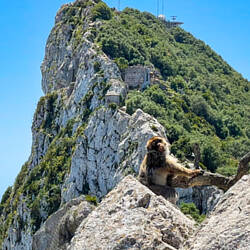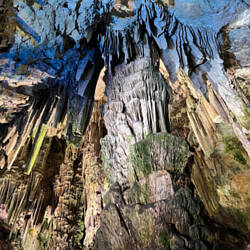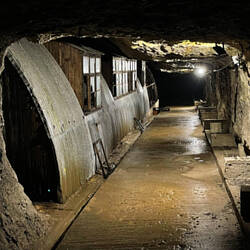Gibraltar: a quirky piece of land
 6 de mayo de 2022, Gibraltar ⋅ ☀️ 29 °C
6 de mayo de 2022, Gibraltar ⋅ ☀️ 29 °C
A single large limestone rock rising out of the Mediterranean Sea, geographically located at the southern end of Spain but formally being British Overseas Territory: welcome to Gibraltar. The Dutch had a hand in helping the British conquer this military strategically located (the Mediterranean Sea is only 14 KM wide here, so no ship can enter the sea without being spotted) piece of land in 1704 and the latter have declined to hand it back to Spain ever since. It’s an ongoing political discussion between the UK and Spain, sparked once again by the Brexit in January 2020. Gibraltar also being part of the European Union held a referendum with a strong 96% in favour of remaining in the EU - leaving it would give significant issues to its economy. Not only does it have work related border traffic of more than 15.000 people per day, it’s also 100% reliant on import of… well basically of everything. A Brexit would imply strict border control and regulations for both people and goods. However not including Gibraltar in the Brexit would likely work against the British negotiation position versus Spain in this ongoing dispute. It was only in the very last hours of 31 December 2019 that the UK and Spain came to a agreement “in principle” to keep Gibraltar in the borderless Schengen area while leaving the EU. All of this resulting in a bit of a funny situation wherein Tim and I can skip the immigration queue entering Gibraltar from Spain (and vice versa) while people with a British passport have to go through formal border control, while actually entering British territory.
Another way to enter Gibraltar if not by land or sea is by air. Little as the territory is, it does have its own airport with only one (short) runway. Lacking more flat land (it’s mostly rock, after all) the runway is crossed by the main road from the border to the city. Whenever a plane needs to land or depart, one simple traffic light and barrier on each side of the landing strip is all there is to stop traffic from colliding with a flying giant. The event of the strip being used will not go unnoticed anywhere in Gibraltar, or directly outside of Gibraltar for that matter, we notice by the deafening noise of airplane engines echoed against the limestone walls.
Just when we buy our tickets for the cable car up the rock we are told that while we can reach the top and come back down by cable car, apparently the nature park of Gibraltar has just closed unexpectedly. The ticket seller doesn’t have more information to share, they don’t know why it’s closed and for how long it will be. “This has never happened before”, she tells us apologetically. With the nature park closed we wouldn’t be able to see any of the other highlights of this territory nor would we be able to walk back down on our own. We are here now anyway so we decide to go up for some English style fish and chips at the top of the rock.
Immediately when our cable car reaches the top we find the next quirky thing about Gibraltar hanging at our cabin: a Barbary Macaque (monkey). Gibraltar is host to the only wild monkey population living in Europe. They have probably been brought here by the Moorish who held them as pets and are thriving here compared to the declining native populations in Morocco. They are well fed (we see various feeding stations throughout the day) and seem to be unbothered by the many tourists taking their picture.
After enjoying our lunch and walk around the top we notice that the entry to the nature park is re-opening. Great news! Apparently the whole park crew was on strike in the morning to join a meeting with a minister, to demand higher wages and better benefits. As the minister said to make a decision only a few days later, they promised to get back to work at least until a decision was made. We spend the afternoon walking around, making our way down by foot while stopping for some of the highlights. For example: one of the natural caves and some of the manmade caves. The most impressive (in my opinion) are the World War II tunnels that we visit with an audio tour. During WWII, the strategic location of Gibraltar was not left unnoticed by Hitler - he wanted to take over the land and tried to convince back then dictator Franco of Spain to let him attack it from Spain. The British anticipated this move by building a massive underground city inside of the rock. It actually contains more than 50 kilometer of tunnel while Gibraltar itself is only 6.8 km2. People lived there for many months at once without seeing daylight. Some were trained and facilitated to stay underground for up to seven(!) years, meaning to stay there (hidden) even after the rock would fall into hostile hands so they could continue to secretly pass on crucial information. The tour and provision of information is well done and we leave the place wiser and impressed. The “secret” operation planned by Hitler eventually never took place, by the way, as Franco wasn’t too keen to get involved in the war.
Some more quirky fun facts about Gibraltar:
- John Lennon and Yoko Ono got married here.
- We saw a seagull try to kill a pigeon, holding it by its cloaca until we scared it off (it first flew away still holding the pigeon, until the latter managed to escape in the air).
- In Gibraltar toilets use salt sea water to flush as water is scarce (and no, we didn’t put this to a test).
- They used to have a habit of dumping old unwanted cars from the cliffs into the sea, apparently you can dive to find a car graveyard underwater.
- (the obvious) One can see the continent of Africa from Gibraltar, as it is so close to Morocco.
After a fulfilling day we pass back over the runway and the border to Spain, where our camper van awaits us in the harbour for the night. A warm shower and beautiful sunset later we get ready for the night.Leer más















Viajerointeressante plek weer. zo leer je nog eens wat op zo'n reis door Europa. En wij erbij.... Gelukkig was de staking snel voorbij. good memories 😉
Nooit geweten van die tunnels. Interessante day trip dus, en idd lachen van dat paspoortverhaal. Tevens uitmuntend gebruik van het woord cloaca 👌 [Evelien]
ViajeroHahaha dank voor die bio les
ViajeroMooi verhaal weer! Dat stukje WWII was mij ook niet bekend. Bedankt voor het delen !